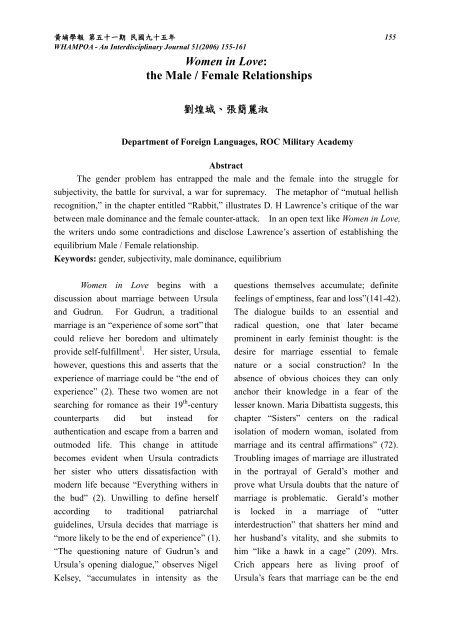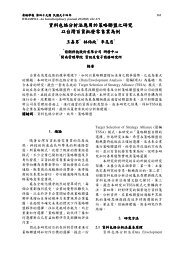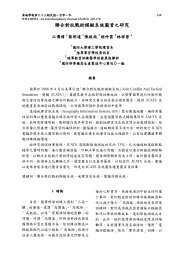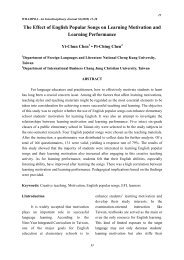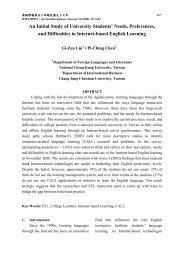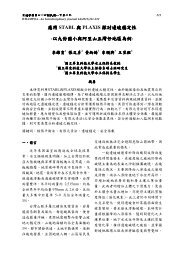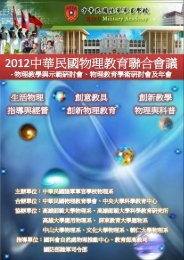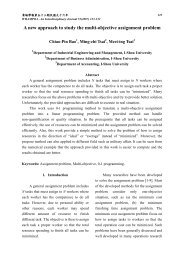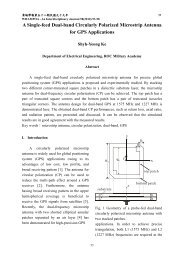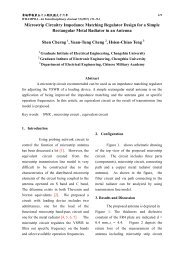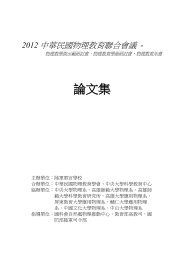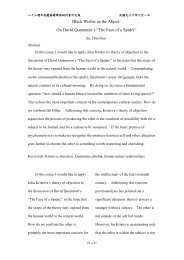Women in Love: the Male / Female Relationships
Women in Love: the Male / Female Relationships
Women in Love: the Male / Female Relationships
You also want an ePaper? Increase the reach of your titles
YUMPU automatically turns print PDFs into web optimized ePapers that Google loves.
黃 埔 學 報 第 五 十 一 期 民 國 九 十 五 年 155<br />
WHAMPOA - An Interdiscipl<strong>in</strong>ary Journal 51(2006) 155-161<br />
<strong>Women</strong> <strong>in</strong> <strong>Love</strong>:<br />
<strong>the</strong> <strong>Male</strong> / <strong>Female</strong> <strong>Relationships</strong><br />
劉 煌 城 、 張 簡 麗 淑<br />
Department of Foreign Languages, ROC Military Academy<br />
Abstract<br />
The gender problem has entrapped <strong>the</strong> male and <strong>the</strong> female <strong>in</strong>to <strong>the</strong> struggle for<br />
subjectivity, <strong>the</strong> battle for survival, a war for supremacy. The metaphor of “mutual hellish<br />
recognition,” <strong>in</strong> <strong>the</strong> chapter entitled “Rabbit,” illustrates D. H Lawrence’s critique of <strong>the</strong> war<br />
between male dom<strong>in</strong>ance and <strong>the</strong> female counter-attack. In an open text like <strong>Women</strong> <strong>in</strong> <strong>Love</strong>,<br />
<strong>the</strong> writers undo some contradictions and disclose Lawrence’s assertion of establish<strong>in</strong>g <strong>the</strong><br />
equilibrium <strong>Male</strong> / <strong>Female</strong> relationship.<br />
Keywords: gender, subjectivity, male dom<strong>in</strong>ance, equilibrium<br />
<strong>Women</strong> <strong>in</strong> <strong>Love</strong> beg<strong>in</strong>s with a<br />
discussion about marriage between Ursula<br />
and Gudrun. For Gudrun, a traditional<br />
marriage is an “experience of some sort” that<br />
could relieve her boredom and ultimately<br />
provide self-fulfillment 1 . Her sister, Ursula,<br />
however, questions this and asserts that <strong>the</strong><br />
experience of marriage could be “<strong>the</strong> end of<br />
experience” (2). These two women are not<br />
search<strong>in</strong>g for romance as <strong>the</strong>ir 19 th -century<br />
counterparts did but <strong>in</strong>stead for<br />
au<strong>the</strong>ntication and escape from a barren and<br />
outmoded life. This change <strong>in</strong> attitude<br />
becomes evident when Ursula contradicts<br />
her sister who utters dissatisfaction with<br />
modern life because “Everyth<strong>in</strong>g wi<strong>the</strong>rs <strong>in</strong><br />
<strong>the</strong> bud” (2). Unwill<strong>in</strong>g to def<strong>in</strong>e herself<br />
accord<strong>in</strong>g to traditional patriarchal<br />
guidel<strong>in</strong>es, Ursula decides that marriage is<br />
“more likely to be <strong>the</strong> end of experience” (1).<br />
“The question<strong>in</strong>g nature of Gudrun’s and<br />
Ursula’s open<strong>in</strong>g dialogue,” observes Nigel<br />
Kelsey, “accumulates <strong>in</strong> <strong>in</strong>tensity as <strong>the</strong><br />
questions <strong>the</strong>mselves accumulate; def<strong>in</strong>ite<br />
feel<strong>in</strong>gs of empt<strong>in</strong>ess, fear and loss”(141-42).<br />
The dialogue builds to an essential and<br />
radical question, one that later became<br />
prom<strong>in</strong>ent <strong>in</strong> early fem<strong>in</strong>ist thought: is <strong>the</strong><br />
desire for marriage essential to female<br />
nature or a social construction? In <strong>the</strong><br />
absence of obvious choices <strong>the</strong>y can only<br />
anchor <strong>the</strong>ir knowledge <strong>in</strong> a fear of <strong>the</strong><br />
lesser known. Maria Dibattista suggests, this<br />
chapter “Sisters” centers on <strong>the</strong> radical<br />
isolation of modern woman, isolated from<br />
marriage and its central affirmations” (72).<br />
Troubl<strong>in</strong>g images of marriage are illustrated<br />
<strong>in</strong> <strong>the</strong> portrayal of Gerald’s mo<strong>the</strong>r and<br />
prove what Ursula doubts that <strong>the</strong> nature of<br />
marriage is problematic. Gerald’s mo<strong>the</strong>r<br />
is locked <strong>in</strong> a marriage of “utter<br />
<strong>in</strong>terdestruction” that shatters her m<strong>in</strong>d and<br />
her husband’s vitality, and she submits to<br />
him “like a hawk <strong>in</strong> a cage” (209). Mrs.<br />
Crich appears here as liv<strong>in</strong>g proof of<br />
Ursula’s fears that marriage can be <strong>the</strong> end
156 黃 埔 學 報 第 五 十 一 期 民 國 九 十 五 年<br />
of experience for a woman.<br />
The radical strategies to combat this<br />
fear becomes a marked trait of Ursula’s<br />
character shown <strong>in</strong> her frequent demand that<br />
Rupert Birk<strong>in</strong> tell her he loves her, and <strong>in</strong><br />
her desire for Birk<strong>in</strong> but her fears of yield<strong>in</strong>g<br />
“her very identity” to him, know<strong>in</strong>g that he<br />
could accept love only on his terms (178).<br />
The symbolic image of <strong>the</strong> drowned couple<br />
provides ano<strong>the</strong>r negative image of union<br />
and offers evidence of how one partner <strong>in</strong> a<br />
male / female relationship may dom<strong>in</strong>ate<br />
and possibly destroy <strong>the</strong> o<strong>the</strong>r. To Ursula,<br />
Birk<strong>in</strong> seems “a beam of essential enmity, a<br />
beam of light that did not only destroy her,<br />
but denied her altoge<strong>the</strong>r, revoked her whole<br />
world. She saw him as a clear stroke of<br />
uttermost contradiction, a strange gem-like<br />
be<strong>in</strong>g whose existence def<strong>in</strong>ed her own<br />
non-existence” (190). To echo Ursula’s<br />
struggle, Birk<strong>in</strong> <strong>in</strong>sists that “<strong>the</strong> old way of<br />
love seemed a dreadful bondage” (191).<br />
His anger over <strong>the</strong> state of marriage matches<br />
Ursula’s, and <strong>in</strong> response he also embraces a<br />
specific “conjunction where man had be<strong>in</strong>g<br />
and woman had be<strong>in</strong>g, two pure be<strong>in</strong>gs,<br />
each constitut<strong>in</strong>g <strong>the</strong> freedom of <strong>the</strong> o<strong>the</strong>r”<br />
(191). He desires impersonal relations<br />
between earnest <strong>in</strong>dividuals. Lawrence<br />
asserts a similar philosophy <strong>in</strong> his letter to<br />
Ca<strong>the</strong>r<strong>in</strong>e Mansfield:<br />
I am sick and tired of personality <strong>in</strong> every<br />
way. Let us be easy and impersonal, not<br />
for ever f<strong>in</strong>ger<strong>in</strong>g over our own souls, and<br />
<strong>the</strong> souls of our acqua<strong>in</strong>tances, but try<strong>in</strong>g<br />
to create a new life, a new common life, a<br />
new complete tree of life from <strong>the</strong> roots<br />
that are with<strong>in</strong> us. (Letters 1: 359)<br />
Birk<strong>in</strong>’s <strong>the</strong>ory of “star equilibrium” takes<br />
its <strong>the</strong>matic cue directly from Lawrence’s<br />
own dream of a healthier, less anxious<br />
exchange between lovers and friends.<br />
Birk<strong>in</strong> persuades Ursula to establish<br />
a union where each commits to <strong>the</strong> o<strong>the</strong>r<br />
while ma<strong>in</strong>ta<strong>in</strong><strong>in</strong>g <strong>the</strong> <strong>in</strong>tegrity of <strong>the</strong> self.<br />
Ursula, however, prefers her own approach<br />
to human affection, and tries to provoke<br />
verbal declarations of love from Birk<strong>in</strong>.<br />
Ursula asks Birk<strong>in</strong> so often to confirm this<br />
spiritual dimension of <strong>the</strong>ir relationship that<br />
Birk<strong>in</strong> calls <strong>the</strong> question her war-cry: “’A<br />
Brangwen, A Brangwen,’--and old<br />
battle-cry.--Yours is ‘Do you love<br />
me?--Yield knave, or die’” (WL, 244).<br />
Despite her yearn<strong>in</strong>g to be loved and her<br />
<strong>in</strong>sistence on <strong>the</strong> supremacy of love over <strong>the</strong><br />
<strong>in</strong>dividual, Ursula is fearful that she will be<br />
consumed by him, and she sometimes<br />
becomes aggressive <strong>in</strong> her resistance to such<br />
envelopment. Lawrence cast Ursula as <strong>the</strong><br />
modern woman with grasp<strong>in</strong>g qualities of<br />
<strong>the</strong> modern cultural degeneration. When<br />
Birk<strong>in</strong> comes to propose to Ursula and ends<br />
up do<strong>in</strong>g so with her fa<strong>the</strong>r <strong>in</strong> <strong>the</strong> room,<br />
Ursula-- flustered, “driven out of her own<br />
radiant, s<strong>in</strong>gle world” by <strong>the</strong> unexpected<br />
proposal--cries out to both men, “why<br />
should I say anyth<strong>in</strong>g?. . . You do this off<br />
your own bat, it has noth<strong>in</strong>g to do with me.<br />
Why do you both want to bully me?” (253).<br />
Her contrar<strong>in</strong>ess about whe<strong>the</strong>r she is <strong>the</strong><br />
owner or <strong>the</strong> owned is succ<strong>in</strong>ctly illustrated<br />
by a s<strong>in</strong>gle sentence from her consideration<br />
of Birk<strong>in</strong>’s proposal: “Let him be her man<br />
utterly, and she <strong>in</strong> return would be his<br />
humble slave--whe<strong>the</strong>r he wanted it or not”<br />
(258).<br />
Ursula tries to f<strong>in</strong>d <strong>the</strong> balance that<br />
allows her to be so close to Birk<strong>in</strong> but not<br />
with <strong>the</strong> sacrifice of her <strong>in</strong>dependent soul.
劉 煌 城 、 張 簡 麗 淑 :<strong>Women</strong> <strong>in</strong> <strong>Love</strong>:<strong>the</strong> <strong>Male</strong> / <strong>Female</strong> <strong>Relationships</strong> 157<br />
This struggle to achieve some equilibrium<br />
presages her modern womanhood. In <strong>Women</strong><br />
<strong>in</strong> <strong>Love</strong>, Leo J. Dorbad found,<br />
“Balance--sexual or o<strong>the</strong>rwise--is a key<br />
factor <strong>in</strong> any critical discussion of <strong>the</strong> novel.<br />
Some form of balance is <strong>in</strong>deed <strong>the</strong> primary<br />
goal of every character” (96). Not only<br />
Ursula and Birk<strong>in</strong>, but also Gerald and<br />
Gudrun encounter <strong>the</strong> challenge of search<strong>in</strong>g<br />
for balance <strong>in</strong> a male / female relationship.<br />
Gerald, for example, is trapped <strong>in</strong> a<br />
deep-seated perversion that might be related<br />
to a pa<strong>in</strong>ful childhood memory--his<br />
accidental kill<strong>in</strong>g of his bro<strong>the</strong>r. Unlike<br />
Birk<strong>in</strong>, Gerald does not enterta<strong>in</strong> lofty<br />
thoughts of spiritual or philosophical<br />
development and derives most of his pride<br />
from his precarious position as an <strong>in</strong>dustrial<br />
magnate. He bl<strong>in</strong>dly dedicates himself to<br />
<strong>the</strong> cont<strong>in</strong>uous mechanization of his family’s<br />
coal m<strong>in</strong>es. He takes over <strong>the</strong> prestigious<br />
position from his rapidly ag<strong>in</strong>g fa<strong>the</strong>r. But<br />
Gerald displays none of his fa<strong>the</strong>r’s<br />
Victorian benevolence. Instead, he sees his<br />
workers as damned spirits, mere robots.<br />
Ironically, he establishes “<strong>the</strong> very<br />
expression of his will, <strong>the</strong> <strong>in</strong>carnation of his<br />
power, a great and perfect mach<strong>in</strong>e, a system,<br />
an activity of pure order, pure mechanical<br />
repetition, repetition and <strong>in</strong>f<strong>in</strong>itum, hence<br />
eternal and <strong>in</strong>f<strong>in</strong>ite” (220). Such an<br />
<strong>in</strong>dividual, flagrantly ignor<strong>in</strong>g <strong>the</strong> <strong>in</strong>tr<strong>in</strong>sic<br />
dignity and personality of o<strong>the</strong>rs, cannot<br />
possibly hope to achieve true connection<br />
with ano<strong>the</strong>r human be<strong>in</strong>g, even <strong>in</strong> matters<br />
of simple friendship. A corrupted soul<br />
from <strong>the</strong> start, he prevents himself from<br />
achiev<strong>in</strong>g what Birk<strong>in</strong> prizes most: freedom<br />
for two.<br />
Gudrun possesses a degree of creative<br />
potential, a s<strong>in</strong>cere desire to lend her world a<br />
spiritual significance beyond <strong>the</strong> merely<br />
sensuous side of life. But even her artistic<br />
endeavors, especially her little figur<strong>in</strong>es,<br />
bear <strong>the</strong> om<strong>in</strong>ous mark of her excessive<br />
willfulness, her tendency toward<br />
manipulation and possessiveness. “From <strong>the</strong><br />
outset of <strong>the</strong>ir relationship”, observes<br />
Charles Rossman, “Gerald and Gudrun are<br />
locked <strong>in</strong> a struggle for mastery over one<br />
ano<strong>the</strong>r” (277). Thwarted and desperate, <strong>the</strong><br />
comb<strong>in</strong>ed wills of Gerald and Gudrun soon<br />
manifest <strong>the</strong>mselves as an extreme lust for<br />
power and beg<strong>in</strong> to usurp what little<br />
tenderness, love, and humanity <strong>the</strong>y share.<br />
The terms of <strong>the</strong>ir unspoken contract are, as<br />
Lawrence says, diabolical:<br />
The bond was established between <strong>the</strong>m,<br />
<strong>in</strong> that look, <strong>in</strong> her tone. In her tone, she<br />
made <strong>the</strong> understand<strong>in</strong>g clear--<strong>the</strong>y were<br />
of <strong>the</strong> same k<strong>in</strong>d, he and she, a sort of<br />
diabolic freemasonry subsisted between<br />
<strong>the</strong>m. Henceforward, she knew, she had<br />
her power over him. Wherever <strong>the</strong>y met,<br />
<strong>the</strong>y would be secretly associated. And<br />
he would be helpless <strong>in</strong> <strong>the</strong> association<br />
with her. Her soul exulted. (114)<br />
Mutual repulsion between Gerald and<br />
Gudrun is an extremely degrad<strong>in</strong>g process.<br />
Noth<strong>in</strong>g less than pure challenge and<br />
needless viciousness, Gerald and Gudrun’s<br />
doomed relationship is rooted <strong>in</strong> <strong>in</strong>fected<br />
ground.<br />
Gudrun once declared her supremacy<br />
over Gerald when she slapped him and said<br />
that she would strike <strong>the</strong> last blow <strong>in</strong> <strong>the</strong>ir<br />
relationship as well as <strong>the</strong> first. Gerald’s<br />
dom<strong>in</strong>ance over <strong>the</strong> maze and m<strong>in</strong>ers<br />
prompts <strong>the</strong> reader to conclude that Gudrun<br />
will not w<strong>in</strong> her battle for supremacy.
158 黃 埔 學 報 第 五 十 一 期 民 國 九 十 五 年<br />
Lawrence conveys <strong>the</strong> colorful obscenities<br />
of <strong>the</strong>ir relationship, its corrosive willfulness<br />
and violent possessiveness, <strong>in</strong> a series of<br />
powerfully dramatized episodes. In <strong>the</strong><br />
“Rabbit” chapter, Gudrun and Gerald<br />
express <strong>the</strong>ir “mutual hellish recognition”<br />
after <strong>the</strong>y are both clawed by <strong>the</strong> rabbit,<br />
Bismarck (234). Gerald’s desire for<br />
dom<strong>in</strong>ation and its l<strong>in</strong>k to violence emerges<br />
when W<strong>in</strong>ifred decides to “frame” ano<strong>the</strong>r<br />
animal by draw<strong>in</strong>g it. When Gudrun tells<br />
Gerald, “We’re go<strong>in</strong>g to draw [<strong>the</strong> rabbit],”<br />
Gerald replied, “Draw him and quarter him<br />
and dish him up” (230). Gudrun smiles at<br />
Gerald’s mockery and <strong>the</strong>ir eyes meet <strong>in</strong> <strong>the</strong><br />
knowledge of <strong>the</strong>ir <strong>in</strong>herent cruelty. They<br />
give full expression to <strong>the</strong>ir mutual<br />
attraction to such power plays when <strong>the</strong>y try<br />
to remove <strong>the</strong> rabbit from its cage--ano<strong>the</strong>r<br />
fram<strong>in</strong>g image. Its frenzied opposition<br />
thwarts Gudrun’s attempt to capture, “a<br />
heavy cruelty well[s] up <strong>in</strong> her,” which<br />
Gerald observes her sullen passion of cruelty<br />
“with subtle recognition” (232). Gerald<br />
responds with similar outrage when he tries<br />
to subdue <strong>the</strong> rabbit and, like Gudrun, is<br />
scratched. This event turns out to be<br />
curiously ritualistic; once aga<strong>in</strong> both lovers<br />
acknowledge <strong>the</strong>ir subterranean attraction<br />
and so reaffirm <strong>the</strong> twisted pact between<br />
<strong>the</strong>m:<br />
Gudrun looked at Gerald with strange,<br />
darkened eyes, stra<strong>in</strong>ed with underworld<br />
knowledge, almost supplicat<strong>in</strong>g, like<br />
those of a creature which is at his mercy,<br />
yet which is his ultimate victor. He did<br />
not know what to say to her. He felt <strong>the</strong><br />
mutual hellish recognition. (234)<br />
Tak<strong>in</strong>g <strong>the</strong>ir lead from such dubious currents<br />
of feel<strong>in</strong>g, Gerald and Gudrun proceed to<br />
engage <strong>the</strong>mselves <strong>in</strong> a program of sexual<br />
warfare and violence, deny<strong>in</strong>g <strong>the</strong>ir potential<br />
capacity for true connection. That Gudrun<br />
and Gerald unite at <strong>the</strong> end of “Rabbit”<br />
chapter <strong>in</strong> “mutual hellish recognition”<br />
becomes an apt metaphor for <strong>the</strong> complexity<br />
of male / female relationships.<br />
Gerald desperately seeks out Gudrun<br />
as his primary source of verified existence,<br />
his only source of work<strong>in</strong>g stimulation.<br />
Rendered helplessly by his own empt<strong>in</strong>ess,<br />
Gerald dra<strong>in</strong>s whatever sustenance he can<br />
from Gudrun: “As he drew nearer to her, he<br />
plunged deeper <strong>in</strong>to her envelop<strong>in</strong>g soft<br />
warmth, a wonderful creative heat that<br />
penetrated his ve<strong>in</strong>s and gave him life aga<strong>in</strong>.<br />
He felt himself dissolv<strong>in</strong>g and s<strong>in</strong>k<strong>in</strong>g to rest<br />
<strong>in</strong> <strong>the</strong> bath of her liv<strong>in</strong>g strength” (337).<br />
Ironically, Gudrun also derives a k<strong>in</strong>d of<br />
passive pleasure from this strange<br />
experience: “and she, subject, received him<br />
as a vessel filled with his bitter potion of<br />
death. She had no power at this crisis to<br />
resist. The terrible frictional violence of<br />
death filled her, and she received it <strong>in</strong> an<br />
ecstasy of subjection, <strong>in</strong> throes of acute,<br />
violent sensation” (337). Both Gudrun and<br />
Gerald transform <strong>the</strong>ir capacity for normal,<br />
healthy sexuality <strong>in</strong>to lust and assertiveness.<br />
In do<strong>in</strong>g so, <strong>the</strong>y make <strong>the</strong>mselves <strong>in</strong>to<br />
agents of death.<br />
“The <strong>in</strong>terchanges between men and<br />
women <strong>in</strong> <strong>Women</strong> <strong>in</strong> <strong>Love</strong>,” as Wendy<br />
Perk<strong>in</strong>s observes, “are complicated by <strong>the</strong><br />
historical moment of <strong>the</strong> novel, an age<br />
where <strong>in</strong>dividuals no longer turn to society<br />
for advice on form<strong>in</strong>g relationships” (233).<br />
Perk<strong>in</strong>s fur<strong>the</strong>r remarks: “As Ursula, Birk<strong>in</strong>,<br />
Gudrun, and Gerald struggle to ga<strong>in</strong><br />
knowledge of <strong>the</strong>mselves through contact
劉 煌 城 、 張 簡 麗 淑 :<strong>Women</strong> <strong>in</strong> <strong>Love</strong>:<strong>the</strong> <strong>Male</strong> / <strong>Female</strong> <strong>Relationships</strong> 159<br />
with each o<strong>the</strong>r, <strong>the</strong>y [re]evaluate gender<br />
roles, rais<strong>in</strong>g questions regard<strong>in</strong>g <strong>the</strong><br />
contradictory impulses of dom<strong>in</strong>ation,<br />
submission, and equality and <strong>the</strong>ir l<strong>in</strong>ks to<br />
human sexuality” (233). In <strong>the</strong> dreary,<br />
<strong>in</strong>dustrialized atmosphere of England,<br />
Ursula, Gudrun, Birk<strong>in</strong>, and Gerald all face<br />
<strong>the</strong> void of modern existence and turn<br />
toward relationship with o<strong>the</strong>rs for salvation.<br />
The process of discover<strong>in</strong>g <strong>the</strong>ir own needs<br />
as <strong>the</strong>y explore unions with o<strong>the</strong>rs <strong>in</strong>volves<br />
complex questions like “a struggle for<br />
consciousness, a search for def<strong>in</strong>ition”<br />
(Mike 216). Lawrence didn’t tell his reader<br />
whe<strong>the</strong>r <strong>the</strong>se characters f<strong>in</strong>d <strong>the</strong> answer <strong>in</strong><br />
<strong>the</strong>ir long years of struggl<strong>in</strong>g. Lawrence has<br />
shown <strong>in</strong> <strong>Women</strong> <strong>in</strong> <strong>Love</strong> “that experience is<br />
equivocal, ambivalent, that <strong>the</strong>re are no clear<br />
answers or wholly adequate resolutions”<br />
(Keith 192). Assert<strong>in</strong>g <strong>the</strong> importance of<br />
represent<strong>in</strong>g <strong>the</strong> ambiguous nature of human<br />
experience, Lawrence writes, “If you try to<br />
nail anyth<strong>in</strong>g down, <strong>in</strong> <strong>the</strong> novel, ei<strong>the</strong>r it<br />
kills <strong>the</strong> novel, or <strong>the</strong> novel gets up and<br />
walks away with <strong>the</strong> nail. Morality <strong>in</strong> <strong>the</strong><br />
novel is <strong>the</strong> trembl<strong>in</strong>g <strong>in</strong>stability of balance.<br />
When <strong>the</strong> novelist puts his thumb <strong>in</strong> <strong>the</strong><br />
scale, to pull down <strong>the</strong> balance to his own<br />
predilection, that is immorality. . . .<br />
And of all <strong>the</strong> art forms, <strong>the</strong> novel most of<br />
all demands <strong>the</strong> trembl<strong>in</strong>g and oscillat<strong>in</strong>g of<br />
<strong>the</strong> balance” (“Morality” 172-73). To<br />
ma<strong>in</strong>ta<strong>in</strong> <strong>the</strong> “trembl<strong>in</strong>g and oscillat<strong>in</strong>g of<br />
<strong>the</strong> balance,” Lawrence leaves <strong>the</strong> four ma<strong>in</strong><br />
characters, as Mark Schorer puts it,<br />
“compounded of a double drive” and free <strong>in</strong><br />
<strong>the</strong> plot to choose between life and death<br />
(53).<br />
In <strong>the</strong> clos<strong>in</strong>g episodes, Ursula and<br />
Rupert leave <strong>the</strong> Alps to choose life, while<br />
Gudrun and Gerald stay <strong>in</strong> <strong>the</strong> mounta<strong>in</strong>s,<br />
engaged <strong>in</strong> a mortal content of wills.<br />
Gudrun is now repelled by Gerald, who<br />
seems to her “like a child that is famished<br />
cry<strong>in</strong>g for <strong>the</strong> breast . . . he needed her to<br />
put him to sleep, to give him repose” (457).<br />
Gudrun rejects both <strong>the</strong> child-man she sees<br />
<strong>in</strong> Gerald and <strong>the</strong> role of nurturer <strong>in</strong> which<br />
he has tried to cast her. For her everyth<strong>in</strong>g<br />
has become “<strong>in</strong>tr<strong>in</strong>sically a piece of irony”<br />
(409). To replace Gerald she s<strong>in</strong>gles out<br />
Loerke, a “small, dark-sk<strong>in</strong>ned man with full<br />
eyes, and odd creature, like a child, and like<br />
a troll, quick, detached” (395). Spurred on<br />
by her unfaithfulness and his gnaw<strong>in</strong>g lack<br />
of stability, Gerald becomes a would-be<br />
murderer and attempts to strangle Gudrun.<br />
Fail<strong>in</strong>g to exercise <strong>the</strong> full force of his will<br />
upon her, he ultimately embraces death as<br />
his only recourse. Nei<strong>the</strong>r Gerald nor<br />
Gudrun is <strong>in</strong>herently evil or demonic, but<br />
<strong>the</strong>ir unwill<strong>in</strong>gness to def<strong>in</strong>e <strong>the</strong>mselves<br />
aga<strong>in</strong>st each o<strong>the</strong>r prevents <strong>the</strong>m from<br />
obta<strong>in</strong><strong>in</strong>g peace. Unable to approximate a<br />
suitable degree of impersonal emotions, <strong>the</strong>y<br />
helplessly witness <strong>the</strong> dis<strong>in</strong>tegration of <strong>the</strong>ir<br />
relationship, permitt<strong>in</strong>g it to lapse <strong>in</strong>to<br />
animal aggression and violent sensuality.<br />
There is, as Eliseo Vivas claims, “a k<strong>in</strong>d of<br />
love between <strong>the</strong> two of <strong>the</strong>m. But it would<br />
be no less <strong>in</strong>adequate to call it ambivalent”<br />
(246). Langbaum ascribes <strong>the</strong> unbalance to<br />
<strong>the</strong> underly<strong>in</strong>g “hate’ <strong>in</strong> <strong>the</strong>ir attraction to<br />
each o<strong>the</strong>r. Schneider calls it “a violent<br />
battle for survival, a war for supremacy, <strong>in</strong><br />
which one of <strong>the</strong> partners must be master<br />
and <strong>the</strong> o<strong>the</strong>r slave” (183). Unable to<br />
determ<strong>in</strong>e <strong>the</strong> limits of <strong>the</strong>ir selfhood, of<br />
<strong>the</strong>ir physical and spiritual boundaries, both<br />
Gerald and Gudrun forever deny <strong>the</strong>mselves
160 黃 埔 學 報 第 五 十 一 期 民 國 九 十 五 年<br />
<strong>the</strong> <strong>in</strong>valuable privileges of balanced love.<br />
Ursula’s marriage with Birk<strong>in</strong> seems a<br />
model of domestic bliss <strong>in</strong> contrast to <strong>the</strong><br />
relationship of Gudrun and Gerald. It is<br />
when her openness to star equilibrium grows<br />
steadily, Ursula “had learned at last to be<br />
still and perfect” (307). After <strong>the</strong>y exchange<br />
tender emotions <strong>in</strong> <strong>the</strong> qua<strong>in</strong>t atmosphere of<br />
a local <strong>in</strong>n, <strong>the</strong>y embark on a refresh<strong>in</strong>g<br />
drive through <strong>the</strong> dark woods of Sherwood<br />
Forest. Both lovers seem to have experience<br />
of profound change. Yet <strong>the</strong> <strong>in</strong>determ<strong>in</strong>ate<br />
end<strong>in</strong>g where Birk<strong>in</strong> suggests he needs a<br />
relationship with a man to be satisfied leaves<br />
<strong>the</strong> question of marriage as a route to<br />
self-fulfillment open. Bar<strong>the</strong>s notes: “To<br />
<strong>in</strong>terpret a text is not to give it a (more or<br />
less justified, more or less free) mean<strong>in</strong>g,<br />
but on <strong>the</strong> contrary to appreciate what plural<br />
constitutes it. . . . [an ideal text conta<strong>in</strong>s] a<br />
galaxy of signifiers, not a structure of<br />
signifieds” (5). What Bar<strong>the</strong>s said echoes<br />
Lawrence’s assertion that “<strong>the</strong> novel most of<br />
all demands <strong>the</strong> trembl<strong>in</strong>g and oscillat<strong>in</strong>g of<br />
<strong>the</strong> balance” (“Morality” 173). Although<br />
Birk<strong>in</strong> and Ursula reconcile <strong>the</strong>ir <strong>in</strong>timate<br />
relationship, <strong>the</strong>y are not brilliantly<br />
counterbalanced, nor do <strong>the</strong>y achieve what<br />
Birk<strong>in</strong> emphasizes <strong>the</strong> star equilibrium,<br />
drawn toge<strong>the</strong>r by <strong>the</strong>ir gravity (love) and<br />
repulsed by <strong>the</strong>ir <strong>in</strong>herent polarity (utter<br />
s<strong>in</strong>gleness). The real balance of male /<br />
female relationship is thus left <strong>in</strong>complete.<br />
The <strong>in</strong>complete becomes an <strong>in</strong>tegral part of<br />
Lawrence’s artistry.<br />
Notes<br />
1 D. H. Lawrence, <strong>Women</strong> <strong>in</strong> <strong>Love</strong>. New<br />
York; pengu<strong>in</strong> Books, 1980, p. 1.<br />
Subsequent textual<br />
citations are to this edition with page<br />
number <strong>in</strong> <strong>the</strong> paren<strong>the</strong>ses<br />
Works Cited<br />
[1] Bar<strong>the</strong>s, Roland. S/Z. Trans. Richard<br />
Miller. New York: Hill and Wang,<br />
1974.<br />
[2] DiBattista, Maria. “<strong>Women</strong> <strong>in</strong> <strong>Love</strong>: D. H.<br />
Lawrence’s Judgment Book.” D.<br />
H.Lawrence: A Centenary Consideration,<br />
edited by Peter Balbert and Philip L.<br />
Marcus. Ithaca: Cornell UP, (1985):<br />
67-90.<br />
[3] Dorbad Leo J. Sexually Balanced<br />
<strong>Relationships</strong> <strong>in</strong> <strong>the</strong> Novels of D. H.<br />
Lawrence. New York: Peter Lang, 1991.<br />
[4] Kelsey, Nigal. D. H. Lawrence: Sexual<br />
Crisis. London: Macmillan, 1991.<br />
[5] Kermode, Frank. “D. H. Lawrence and<br />
<strong>the</strong> Apocalyptic Types,” Cont<strong>in</strong>uities,<br />
New York: Random House, (1968):<br />
122-51.<br />
[6] Lamgbaum, Robert. The Mysteries of<br />
Identity: A Theme <strong>in</strong> Modern Literature.<br />
New York: Oxford UP, 1977.<br />
[7] Lawrence, D. H. “Morality and <strong>the</strong><br />
Novel.” Study of Thomas Hardy and<br />
O<strong>the</strong>r Essays. Ed. Bruce Steele.<br />
Cambridge: Cambridge UP, 1985:<br />
171-76.<br />
[8] ---The Collected letters of D. H.<br />
Lawrence. Ed. Harry T. Moore. 2 vols.<br />
New York: Vik<strong>in</strong>g, 1962.<br />
[9] Mike, Stephen. Toward <strong>Women</strong> <strong>in</strong> <strong>Love</strong>:<br />
The Emergence of a Lawrentian<br />
Aes<strong>the</strong>tic. New Haven: Yale UP. 1971.<br />
[10] Perk<strong>in</strong>s, Wendy. “Read<strong>in</strong>g Lawrence’s<br />
Frames: Chapter Division <strong>in</strong> <strong>Women</strong> <strong>in</strong><br />
<strong>Love</strong>” The D. H. Lawrence Review. ( 3<br />
Fall 1992): 229-246.<br />
[11] Ross, Charles L. <strong>Women</strong> <strong>in</strong> <strong>Love</strong>: A
劉 煌 城 、 張 簡 麗 淑 :<strong>Women</strong> <strong>in</strong> <strong>Love</strong>:<strong>the</strong> <strong>Male</strong> / <strong>Female</strong> <strong>Relationships</strong> 161<br />
Novel of Mythic Realism. Boston:<br />
Twayne, 1991.<br />
[12] Rossman, Charles. “‘You are <strong>the</strong> Call<br />
and I am <strong>the</strong> Answer’: D. H. Lawrence<br />
and <strong>Women</strong>.” D. H. Lawrence Review<br />
8 (1975): 255- 328.<br />
[13] Sagar, Keith D. H. Lawrence: Life <strong>in</strong>to<br />
Art. A<strong>the</strong>ns: U of Georgia P. 1985.<br />
[14] Schorer, Mark. “<strong>Women</strong> <strong>in</strong> <strong>Love</strong> and<br />
Death.” D. H. Lawrence: A Collection<br />
of Critical Essays, ed. Mark Spilka,.<br />
Englewood cliffs, N. J.: Prentice-Hall,<br />
1963: 50-60.<br />
[15] Spilka, Mark. “Defend<strong>in</strong>g lawrence.” D.<br />
H. Lawrence Review 20.3 1988:<br />
311-13.<br />
[16] Vivas, Eliseo. D. H. Lawrence: The<br />
Failure and <strong>the</strong> Triumph of Art.<br />
Evanston: Northwestern UP, 1960.<br />
摘 要<br />
本 論 文 旨 在 探 討 勞 倫 斯 所 著 《 戀 愛 中 的 女 人 》 的 兩 性 關 係 。《 戀 愛 中 的 女 人 》 呈 現 傳 統<br />
與 現 代 男 女 對 婚 姻 愛 情 的 不 同 觀 念 。 作 者 以 後 現 代 理 論 檢 視 文 本 中 性 別 、 婚 姻 、 父 權 、<br />
物 質 及 心 靈 的 對 比 以 闡 明 書 中 主 角 柏 金 所 提 倡 的 兩 性 平 權 , 相 敬 互 助 的 男 女 關 係 。 作 者<br />
企 圖 解 構 文 本 中 男 女 主 角 對 於 愛 情 、 婚 姻 的 矛 盾 論 述 , 來 看 勞 倫 斯 在 《 戀 愛 中 的 女 人 》<br />
所 呈 現 的 生 活 哲 學 。<br />
關 鍵 詞 : 性 別 、 父 權 、 傳 統 與 現 代 、 解 構 、 矛 盾 論 述
162 黃 埔 學 報 第 五 十 一 期 民 國 九 十 五 年


